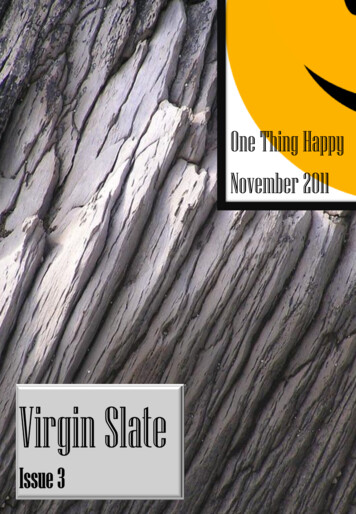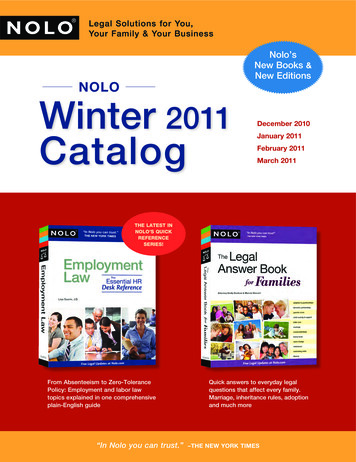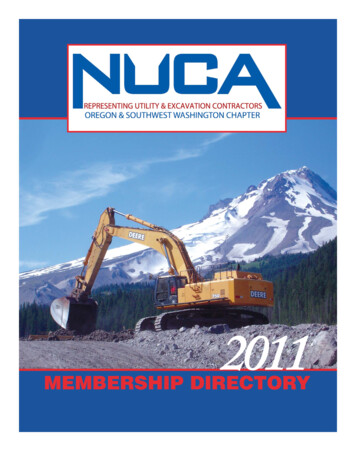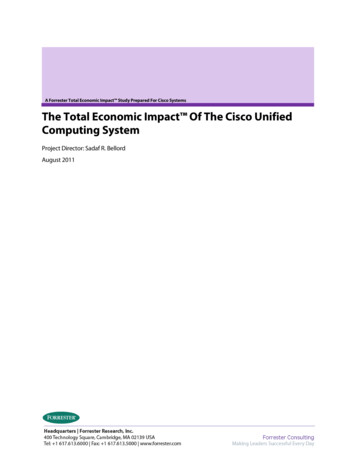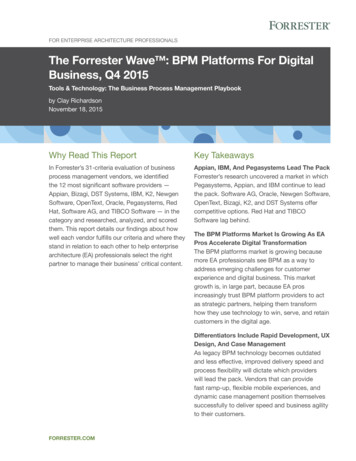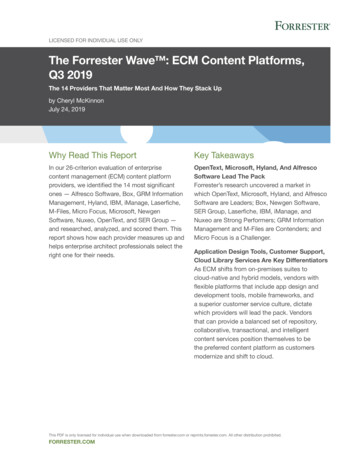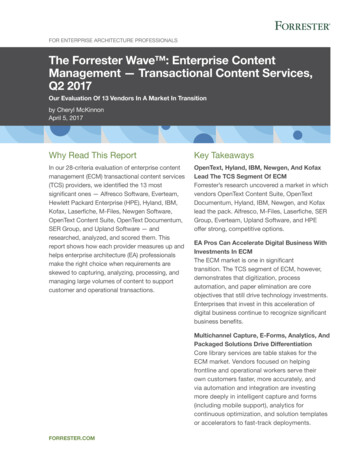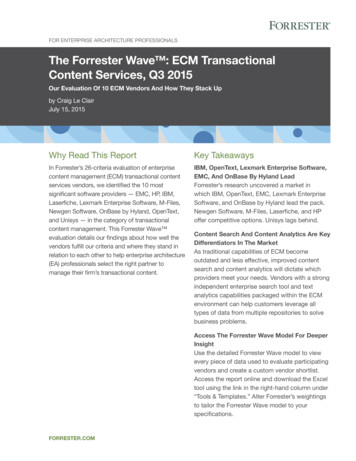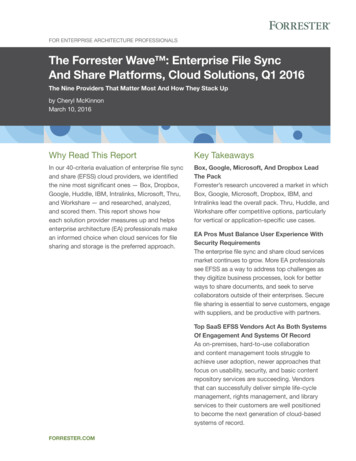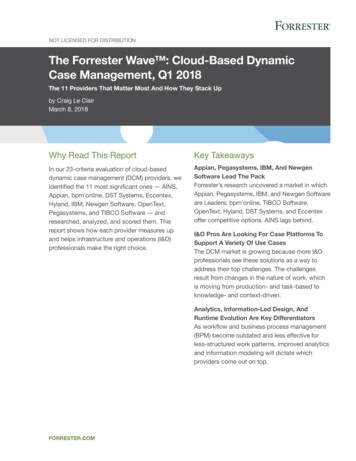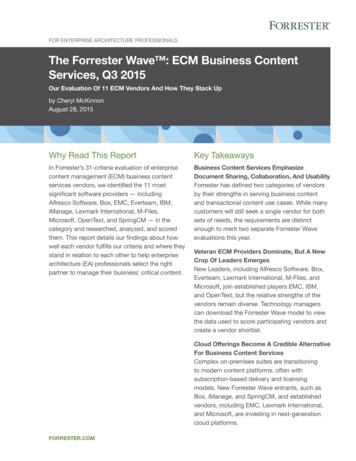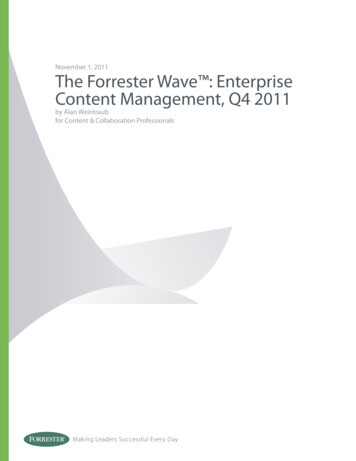
Transcription
November 1, 2011The Forrester Wave : EnterpriseContent Management, Q4 2011by Alan Weintraubfor Content & Collaboration ProfessionalsMaking Leaders Successful Every Day
For Content & Collaboration ProfessionalsNovember 1, 2011The Forrester Wave : Enterprise ContentManagement, Q4 2011EMC, IBM, OpenText, And Oracle Lead, With Microsoft Close Behindby Alan Weintraubwith Stephen Powers and Anjali YakkundiExec ut i v e S u mma ryIn Forrester’s 66-criteria evaluation of enterprise content management (ECM) vendors, we found thatEMC, IBM, OpenText, and Oracle lead the pack because of their abilities to address all four contentcentric technology areas. Microsoft challenges the leaders with enhanced capabilities in business,foundational, and persuasive content. Strong Performer Hyland Software strengthens its position byenhancing its business and foundational capabilities to complement its traditional image and archivefocus. Strong Performers HP and Xerox find success by targeting business and foundational content,while Strong Performer Perceptive Software targets business and transactional content. Contender AllenSystems Group (ASG) has found success by focusing on transactional content, and Contender AlfrescoSoftware continues to strengthen its ECM functionality by focusing on business and foundational content.ta bl e o f Co ntents2 Say Goodbye To ECM Suites; Content-CentricTechnologies Are ECM’s Future3 Role Players Put Pressure On The TraditionalHeavyweights5 ECM Vendor Evaluation OverviewEvaluation Criteria: Current Offering, Strategy,And Market PresenceSelected Vendors Are True Enterprise-ClassSolutions7 The Four Horsemen Lead While Role PlayersAddress Specific Content AreasN OT E S & R E S OUR CE SForrester evaluated 12 products and 36 usercompanies.Related Research Documents“The Forrester Wave : Web Content ManagementFor Online Customer Experience, Q3 2011”July 13, 2011“Plan Your ECM Strategy For Business, Persuasive,Transactional, And Foundational Needs”April 14, 201116 Vendor Profiles20 Supplemental Material 2011 Forrester Research, Inc. All rights reserved. Forrester, Forrester Wave, RoleView, Technographics, TechRankings, and Total EconomicImpact are trademarks of Forrester Research, Inc. All other trademarks are the property of their respective owners. Reproduction or sharing of thiscontent in any form without prior written permission is strictly prohibited. To purchase reprints of this document, please email clientsupport@forrester.com. For additional reproduction and usage information, see Forrester’s Citation Policy located at www.forrester.com. Information isbased on best available resources. Opinions reflect judgment at the time and are subject to change.
2The Forrester Wave : Enterprise Content Management, Q4 2011For Content & Collaboration Professionalssay goodbye to Ecm suites; content-centric technologies are ecm’s futureOrganizations continue to grapple with an explosion of unstructured content.1 In additionto the sheer amount of content, the types of content are becoming increasingly diverse andinclude: documents, scanned images, web content, rich media, email, corporate records, blogs,wikis, e-forms, audio, and video. Each content type comes with its own editing and workflowrequirements, and often regulatory and compliance pressures, making managing content that muchmore complicated and expensive. At the same time, information workers still demand simple andeasy-to-use content management tools.Stuck in the middle of these complex content management issues, few organizations hold onto theonce highly touted ECM ideal: an ECM suite from a single vendor that sits atop a unified contentrepository. For many, a one-size-fits-all ECM solution is no longer relevant or feasible and insteadthey look to ECM technologies to solve specific business needs. These organizations have begun tomove to a more content-centric approach, as they look for different solutions to manage specifictypes of content.Forrester divides the technologies used to support these sets of content types into four areas:foundational, business, transactional, and persuasive (see Figure 1).2· Foundational ECM provides basic content management functionality. Foundational contenttechnologies deliver a core set technologies. These technologies include library services, basicworkflow, search, and records management and are common across most ECM solutions.· Business ECM drives the day-to-day workplace experience. Business content technologiesprovide the capabilities that enable workers to perform their day-to-day tasks and collaboratewith their colleagues. These technologies include compound document management, enterpriserights management, and team collaboration.· Transactional ECM drives back-office processes. Transactional content technologies supportthe processes that integrate content with back-office applications. Imaging, document outputmanagement, and business process management form the backbone of the transactional contenttechnologies.· Persuasive ECM supports content that influences external audience behavior. Persuasivecontent technologies deliver content that supports multichannel marketing, lead generation,and customer self-service. Examples of persuasive ECM include web content management,digital asset management, and document output for customer communications management.November 1, 2011 2011, Forrester Research, Inc. Reproduction Prohibited
The Forrester Wave : Enterprise Content Management, Q4 2011For Content & Collaboration ProfessionalsBFigure 1 The ECM Spectrum: Understanding The Content Types And The TechnologiesUSESNSITRAEnterprise agementLibrary TMFPTaxonomyRecords PERSUASIVE59991Source: Forrester Research, Inc.role players Put Pressure On The Traditional HeavyweightsA few key players — IBM, EMC, OpenText, and Oracle — have traditionally dominated the ECMmarket. But the tides have begun to turn toward a set of role players that focus on certain areasof the ECM spectrum rather than the whole thing. Organizations develop their ECM strategiesgeared toward implementing specific content-related applications (e.g., invoice processing, contractmanagement, or quality assurance). This application-specific strategy is the driving factor thatis encouraging vendors still focused on a suite approach to become more focused on contenttechnologies.Microsoft SharePoint’s strategy of “ECM for the masses” has also forced ECM vendors to becomeincreasingly more content-centric. CIOs already have tight budgets and will become reluctant tosource additional ECM technology if SharePoint can suffice. As such, other vendors have begun togravitate toward supporting specific content sets in order to differentiate themselves from Microsoftand other heavy hitters. 2011, Forrester Research, Inc. Reproduction ProhibitedNovember 1, 20113
4The Forrester Wave : Enterprise Content Management, Q4 2011For Content & Collaboration ProfessionalsThe fracturing of the ECM market has led to a host of players, which include:· Traditional ECM suite vendors. Traditional suites players include the heavyweights: EMC,IBM, OpenText, and Oracle. They provide end-to-end ECM offerings that manage all fourcontent types: business, transactional, persuasive, and foundational. These suites generally arecomplex and heavy solutions that require significant investment of resources. However, theupside is that they offer a single platform. While some organizations have turned away fromthe suite approach, the traditional players still do them well and offer attractive packages toenterprise-level consumers.· Open source solutions. Both Alfresco and Nuxeo offer ECM capabilities that addressfoundational and business content technologies. Alfresco leads Nuxeo in client implementationsand functionality. While both vendors offer extensive ECM functionality, Alfresco addsteam and project collaboration capabilities including blogs, wikis, calendars, data lists, anddiscussion threads. Other vendors — such as Drupal and DotNetNuke — have a greater focuson supporting online persuasive initiatives.· Content-focused vendors. These vendors tend to be the David to the traditional ECM suites’Goliath by focusing on specific content technologies instead of trying to be a one-size-fits-allsolution. Vendors like Alfresco and Xerox have chosen to focus on managing business content,while ASG, Laserfiche, and Perceptive focus on transactional content. Hyland epitomizes therole of David as it takes on the ECM suite vendors: It initially focused on transactional contentbut now has broadened to include both business and foundational content. A host of players —including the traditional ECM suite vendors — focus on web content management (WCM) anddigital asset management (DAM) solutions in support of persuasive content.3· Cloud vendors. Organizations are looking to the cloud for ways to reduce initial startup costsand streamline implementations. Some companies resisted moving ECM solutions to a cloudenvironment due to security, integration, and customization concerns. They asked vendors toprove that their solutions were secure and provided all the functionality and performance ofan on-premises ECM implementation. Three vendors have emerged as cloud-only vendors:KnowledgeTree, SpringCM, and Veeva Systems. KnowledgeTree focuses on business content,while SpringCM focuses on transactional content. Veeva recently launched a cloud offering toservice the regulatory requirements of the life sciences industry.· Industry-specific players. Many vendors choose to focus on a specific vertical. For example,the legal industry provides a fertile ground for ECM products such as Autonomy’s iManage,NetDocuments, and OpenText’s eDocs. Other verticals that specific ECM vendors target includehealthcare and higher education. Both Hyland and Perceptive create specific solutions thataddress the challenges of these markets, including predefined integrations with the leadingoperational systems.November 1, 2011 2011, Forrester Research, Inc. Reproduction Prohibited
The Forrester Wave : Enterprise Content Management, Q4 2011For Content & Collaboration Professionals· European vendors. An array of European vendors focus on regional markets. Ever Team,covering France, Spain, and the Middle East, supports business and transactional contentcentric applications. Germany-based Saperion targets transactional-content-centric applicationsby providing archiving, document management, capture, COLD, e-signature, email, and recordsmanagement functionality. (Saperion’s attempt to move into the North American market withSAP integration support has only been moderately successful.)ECM Vendor Evaluation OverviewTo assess the state of the ECM market and see how the vendors stack up against one another,Forrester evaluated the strengths and weaknesses of top ECM vendors (see Figure 2).Evaluation Criteria: Current Offering, Strategy, And Market PresenceAfter examining past research, user need assessments, and vendor and expert interviews, wedeveloped a comprehensive set of evaluation criteria. We evaluated vendors against 66 criteria,which we grouped into three high-level buckets:· Current offering. We focused on ECM tool breadth and extended capabilities for managingcontent. The evaluations took into account the four ECM technology areas: business,transactional, persuasive, and foundational. Persuasive content support is evaluated in moredepth in “The Forrester Wave : Web Content Management For Online Customer Experience,Q3 2011.”4· Strategy. ECM vendors must show coherent strategies that help organizations align ECMtechnologies with overall information management needs. Vendors also must have an extensivenetwork of system integrators and ISVs in order to ease the often-painful implementationprocess. We also examined vendors’ product road maps, corporate strategy, and partnershipactivity in order to evaluate strategy.· Market presence. We evaluated vendors’ current installed bases, the size of the ECM productrevenue, vendors’ overall revenue, and geographic presence.Selected Vendors Are True Enterprise-Class SolutionsForrester included 12 vendors in the assessment: Alfresco, ASG, EMC, HP, Hyland Software, IBM,Laserfiche, Microsoft, OpenText, Oracle, Perceptive, and Xerox. Vendors were selected because theyeach displayed the following:· Functionality breadth. Evaluated vendors’ ECM offering includes specific and robustfunctionality for at least one of the following content types: business, persuasive, transactional,and/or foundational. Offerings must include most or all of the following: document 2011, Forrester Research, Inc. Reproduction ProhibitedNovember 1, 20115
6The Forrester Wave : Enterprise Content Management, Q4 2011For Content & Collaboration Professionalsmanagement, document imaging, records management, web content management, digital assetmanagement, and document output for customer communications management.· Leadership in information management. Selected vendors are leading providers ofinformation management technology, and many provide relational database managementsystems, business intelligence (BI), portal, and collaboration. Vendors have shared withForrester strategic road maps addressing investments in ECM functionality.· Proven enterprise-level track record. Included vendors have a solid existing consumer baseamong customers having revenues over 1 billion annually and have proven scalability. Thesevendors typically have well over 25 million in revenue.· Interest from Forrester clients. Forrester clients continue to ask about the evaluatedproducts within the context of inquiry, advisory, and/or consulting. Many clients have alreadyimplemented these solutions to support their information management agenda.November 1, 2011 2011, Forrester Research, Inc. Reproduction Prohibited
The Forrester Wave : Enterprise Content Management, Q4 2011For Content & Collaboration ProfessionalsFigure 2 Evaluated Vendors: Product Information And Selection CriteriaProduct versionevaluatedVersionrelease dateVendorProduct evaluatedAlfresco SoftwareAlfresco Enterprise Edition 3.4ASGASG-ViewDirect Suite**EMCDocumentum**HPHP Trim7.1March 2011Hyland SoftwareOnBase10August 2010IBMIBM ECM Suite5.0.0December 2010LaserficheLaserfiche Rio8.2.1May 2011MicrosoftMicrosoft SharePoint Server 20104May 2010OpenTextOpenText ECM Suite2010September 2010OracleOracle WebCenter11gR1May 2011Perceptive SoftwareImageNow6.6XeroxDocuShare6.5.33.4January 2011February 2011May 2010Vendor selection criteriaVendor’s ECM suite offers specific and robust functionality for at least one of the following content types:business, persuasive, transactional, and/or foundational.Vendor is a leading provider of information management technology.Vendor has a solid enterprise track record, and Forrester clients show interest in these products in thecontext of inquiry, advisory, and consulting.*Multiple components with different product version numbers and release datesSource: Forrester Research, Inc.The Four Horsemen lead while role players address specific content areasOur evaluation uncovered a segmented market in which (see Figure 3, see Figure 4, see Figure 5,and see Figure 6):· EMC, IBM, OpenText, and Oracle continue to lead the pack across all ECM technologies.The four horsemen of ECM continue to deliver a comprehensive suite of ECM functionalitythat addresses all aspects of the four ECM technology areas. Their ability to address the widerange of technologies encompassing the content spectrum provides a one-stop shop for ECMfunctionality from a single vendor. 2011, Forrester Research, Inc. Reproduction ProhibitedNovember 1, 20117
8The Forrester Wave : Enterprise Content Management, Q4 2011For Content & Collaboration Professionals· Microsoft continues to gain on the four horsemen. Microsoft has extended its ECMfunctionality in SharePoint 2010, enabling it to move into a Leader position in two of the ECMtechnology areas: foundational and business. The general lack of support for the imaging andoutput management technologies leaves Microsoft as a Contender in the transactional area. This,coupled with still maturing web content management and digital asset management capabilities,gives Microsoft an overall Strong Performer position.· Hyland broadens its offering to address multiple ECM technology areas. Hyland continuesto enhance its ECM functionality to address multiple technology areas (e.g., team collaboration,records management, and mobile computing). But Hyland’s lack of support for persuasivetechnologies and global enterprise deployments holds it back from becoming a Leader in thisevaluation.· ASG, HP, Laserfiche, Perceptive, and Xerox provide rich functionality with a narrowfocus. ASG, HP, Laserfiche, Perceptive, and Xerox deliver ECM solutions that offer capabilitiestargeted at specific technology areas. These vendors rank as Contenders or Strong Performersin the technologies areas in which they provide their richest set of ECM functionality. Theirfunctionality in these technology areas gives them their highest scores for their current offering.· Open-source-based Alfresco continues to be an alternative to proprietary players. Alfresco’sfocus on foundational and business content provides organizations with a low-cost alternativeto the larger proprietary vendors. Alfresco’s continued development in the foundational areamakes it relevant to enterprises.This evaluation of the ECM market is intended to be a starting point only. We encourage readersto view detailed product evaluations and adapt the criteria weightings to fit their individual needsthrough the Forrester Wave Excel-based vendor comparison tool.November 1, 2011 2011, Forrester Research, Inc. Reproduction Prohibited
The Forrester Wave : Enterprise Content Management, Q4 2011For Content & Collaboration ProfessionalsFigure 3 Forrester Wave : Enterprise Content Management, Q4 ’11 trongOpenTextEMCOracleIBMGo online to downloadthe Forrester Wave toolfor more detailed productevaluations, featurecomparisons, andcustomizable rankings.Hyland SoftwareMicrosoftXeroxHPAlfresco SoftwarePerceptive SoftwareASGLaserficheCurrentofferingMarket presenceFull vendor participationIncomplete vendor participationWeakWeakStrategyStrongSource: Forrester Research, Inc. 2011, Forrester Research, Inc. Reproduction ProhibitedNovember 1, 20119
The Forrester Wave : Enterprise Content Management, Q4 2011For Content & Collaboration Figure 3 Forrester Wave : Enterprise Content Management, Q4 ’11 Overall (Cont.)Forrester’sWeighting10CURRENT OFFERINGFoundational content supportBusiness content supportTransactional content supportPersuasive content supportCore capability GYProduct strategyWhole solution strategyProduct packaging strategyLicensing and 3.022.604.302.500.002.912.603.603.750.00MARKET PRESENCECompany financialsTrainingECM customer baseGeographic 1.801.000.752.800.002.651.403.004.000
The Forrester Wave : Enterprise Content Management, Q4 2011 For Content & Collaboration Professionals 4 The fracturing of the ECM market has led to a host of players, which include: · Traditional EC
